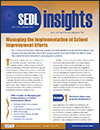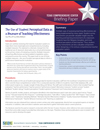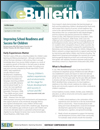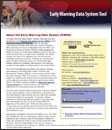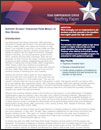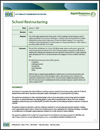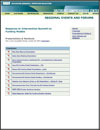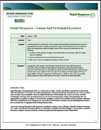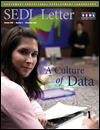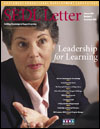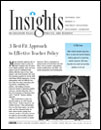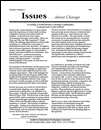SEDL's Free A-Z List of Free Resources for Improving School Performance
Improving School Performance
All Products in this Category
Products are listed by date published.
This biannual update provides a list of resources that focus on college- and career-readiness standards and assessment.
This biannual update provides a list of resources that focus on college- and career-readiness standards and assessment. It includes materials from the federal content centers, comprehensive centers, and regional educational laboratories, as well as other organizations with expertise in education policy, research, and technical assistance.
This biannual update provides a list of resources that focus on college- and career-readiness standards and assessment. It includes materials from the federal content centers, comprehensive centers, and regional educational laboratories, as well as other organizations with expertise in education policy, research, and technical assistance.
The Southeast Comprehensive Center (SECC) and the Texas Comprehensive Center (TXCC) at SEDL are hosting the Regional Institute, Supporting High-Quality Rural Education, at the Embassy Suites Austin - Central Hotel in Austin, Texas, on November 5–7, 2014.
“Professional learning communities,” the name given to teachers’ collaborative professional learning—or PLCs, as they are often called—has become so overused that we often don’t think about the term’s meaning. Only when teachers reflect on their instructional practice, consider the impact instruction has on students, and implement insights gained from a meeting to improve their teaching performance, can this process be called a professional learning community. This issue of SEDL Insights explores ways that education leaders can guide their staff in the implementation of effective PLCs.
Research over the past 30 years has found that effective principals can significantly improve various components of student achievement and learning. In addition, there are few examples of improving student achievement that were not led by an effective principal. Research has also identified the need for the change to be systemic or comprehensive in the school turnaround process to ensure sustainability. Along with a systemic improvement process, Duke (2006), identifies 10 “essential” school components for the turnaround principal’s focus and action as keys to sustained success for the benefit of all students. This briefing paper addresses the essential competencies and actions of the turnaround principal.
For a school improvement initiative to succeed, education leaders must do more than adopt a new program and train staff. This issue of SEDL Insights explores steps that leaders can take to ensure the successful implementation of a new program or practice.
Staff members from states in the Southeast Region met with their counterparts in the area of school turnaround and learned from experts in the field from the U.S. Department of Education and other organizations.
This resource was produced in response to a request from a state department of education (SDE) served by the Southeast Comprehensive Center (SECC) at SEDL that requested information regarding teacher shortages, specifically merit pay, compensation strategies, and other actions taken or under consideration by SDEs to address this issue.
The literature on teacher preparation programs in the United States is extensive. However, there is limited scientifically based research on what kind of program produces effective teachers; rather, the literature consists mostly of calls for change in teacher preparation programs. Almost all experts agree that major changes are needed in these programs, with the emphasis being to produce teachers who are effective in enhancing student learning.
This paper reports evidence-based research and offers suggestions based on studies that include theoretical work, qualitative analysis, statistical analysis, and randomized experience that could provide strong causal evidence of the effects of teacher preparation on student learning.
States are carefully reviewing their teacher evaluation systems to make them more meaningful and comprehensive by including multiple measures. This paper looks at one of those multiple measures—the use of student perceptual data to inform a performance-based teacher evaluation.
This brief examines how rural districts and schools can integrate the unique attributes and resources found in rural communities into improvement efforts to promote the transformation of low-performing schools.
This briefing paper provides details on the meaning of college- and career-readiness standards, effective implementation of these standards, next steps in the implementation process, and progress being made by state departments of education in the Southeast toward this crucial goal.
This webinar was held November 7, 2011, and discusses the U.S. Department of Education's technical assistance program for implementing provisions of the Elementary and Secondary Education Act. The author of an independent national evaluation of the program presented the study's major findings, and participants in the webinar had the chance to ask questions and discuss key elements with state officials.
This brief examines the complex issue of the impact of class time lengths on student achievement, with a focus on the school year, school day, and how classroom time is spent.
Including presentations and a webinar, these materials are from a teacher evaluation systems institute at which nearly 50 state education leaders convened in New Orleans, Louisiana, on July 27–28, 2011. Participants engaged in sessions led by experts in the field, learned about the progress and challenges of other states, and discussed with their colleagues the steps their respective states need to take to implement a comprehensive teacher evaluation system. They also had the opportunity to meet with nationally recognized educators and researchers—Charlotte Danielson, Laura Goe, and Lynn Holdheide—to learn about best practices and current work in the area of teacher evaluation systems.
SEDL's Research and Evaluation staff conducted an evaluation of the extent to which the PTLC process was changing teaching and learning in the Georgetown County School District. This report summarizes recent evaluation findings regarding the achievement of expected outcomes associated with the process.
SEDL's Research and Evaluation staff conducted an evaluation of the extent to which the PTLC process was changing teaching and learning in the Lancaster County School District. This report summarizes recent evaluation findings regarding the achievement of expected outcomes associated with the process.
This edition of the Southeast Comprehensive Center eBulletin highlights data on high school graduation rates.
In this edition of the Southeast Comprehensive Center (SECC) eBulletin we highlight school readiness, how early experiences matter, the role of preschool in supporting
readiness, and state and local efforts to implement recommendations from the National Governors Association (NGA).
This brief addresses the question: What research or promising practices should an individual district or a cooperative among several districts consider with regard to the establishment of an alternative high school in a rural area?
The Early Warning Data System (EWDS) Tool tracks research-based ninth-grade indicators related to high school dropout, such as attendance and academics, and automatically flags students who are below the specified benchmarks leading to graduation. The tool provides leading indicators so that school staff can quickly review data and plan interventions as early as 20 to 30 days after the beginning of the school year.
This issue of the Southeast Comprehensive Center eBulletin summarizes some of the best practices in turning around schools and provide readers with references and resources to gain a deeper knowledge of the literature on turning around low-performing schools and strategies to help state departments and districts in their attempt to reform challenging schools.
This brief was developed by SEDL's Texas Comprehensive Center to answer the question, "What strategies can be implemented to aid students and their parents in the transition from eighth grade into high school?" The transition from eighth grade to high school results in a higher drop-out rate and more grade retentions than any other grade. However, when districts and schools develop and implement a sound transition program, the outcomes for ninth graders are improved.
This resource was developed in response to a request from a state departments of education in the Southeast Comprehensive Center’s region that had started the process of working on a takeover plan and wanted to compile research from other states in the area of school and district takeover. The requestor was interested in the development of a white paper on this process thus far in other states, to provide possible direction for its state.
This resource was produced in response to a request from a state department of education (SDE) served by the Southeast Comprehensive Center (SECC). The SDE requested information on Web-based state data systems that can generate customized reports for stakeholders for analyzing student and school performance. The SDE also would like to identify any states that have Web-based data systems that guide school improvement planning through the retrieval of school data; multiyear, disaggregated student assessment data; and suggested resources for addressing areas in need of improvement. The requester is particularly interested in obtaining access to view other data systems, such as those in the states of Massachusetts and Iowa.
The objectives of the Response to Intervention Summit on Funding Models were to increase knowledge of funding models for RtI implementation, to develop strategies and action steps for addressing RtI funding, and to increase networking opportunities for improved implementation of funding models
School improvement isn’t just about schools. It’s also about students and teachers, and how education leaders at all levels—state, district, school, and classroom—work together to help students succeed. This issue of SEDL Letter explores school improvement in a variety of areas.
In this edition of the Southeast Comprehensive Center (SECC) eBulletin we highlight the issues of teacher quality and the equitable distribution of effective teachers. We hope that the information included in this issue will provide you details on research and practice occurring both nationally and within our region. Be sure to read the stories from our states about their work in this area to find some innovative strategies for addressing both the teacher effectiveness issue and the teacher shortage issue that exists in some areas.
The Southeast CC Spotlight highlights resources, materials, technical assistance, and professional development services offered by the Southeast Comprehensive Center (SECC) at SEDL. The newsletter also focuses on the work that SECC does with the states of Alabama, Georgia, Louisiana, Mississippi, and South Carolina to build their capacity to implement the programs and goals of the No Child Left Behind Act of 2001 (NCLB).
Meeting the goals of No Child Left Behind (NCLB) is tough for everyone involved—schools, districts, and states. That's why the Texas Comprehensive Center (TXCC) is producing Texas Focus, a quarterly newsletter. Each edition will focus on challenges that Texas educators face. In addition, the newsletter offers a review of the TXCC's recent events and activities as well as national news regarding NCLB. We hope you will find information here that stimulates your thinking and increases your knowledge about resources, practices, and programs that support the achievement of the goals and purposes of NCLB.
This resource was developed in response to a request: "A state department of education (SDE) served by the Southeast Comprehensive Center has requested that the SECC identify successful U.S. high schools that focus more on technical rather than traditional academic subjects. Also, the SDE would like information on the following: 1. Do these schools require Carnegie units? How are technical courses coded if Carnegie units are awarded? 2. How is credit given for technical job-training classes? 3. What types of terminal degrees are offered at these schools?
This resource was produced in response to a request: "A state department of education would like information on how states are educating overage students who may be at least two grades behind and are at risk of dropping out of high school. In particular, some districts want to enroll students with their age group, in an alternative setting, or in a vocational program."
This resource was produced in response to a request: "How are states across the nation using project-based learning (PBL)? Has PBL been implemented in elementary, middle, and high schools? If so, when was it implemented, and what results have schools and districts experienced?" In response to this request, the Southeast Comprehensive Center (SECC) queried several state departments of education as well as the REL Southeast at the SERVE Center, the National High School Center, and the National Center for Research on Evaluation, Standards, and Student Testing (CRESST) to obtain information on the use of PBL in schools nationwide.
SEDL's Southeast Comprehensive Center developed this resource in response to a request from a state department of education for the following information about Response to Intervention practices: For Tiers II and III, what does the research indicate about pupil/teacher ratios for optimal or maximum small group instruction? Do small group size numbers change with grade levels? What does the research indicate about intervention effectiveness beyond implementation fidelity—group size, minutes per day, and days per week?
SEDL's Southeast Comprehensive Center (SECC) developed this resource in response to a request: "Do other states in the southeastern region have written policies regarding Response to Intervention and how do those states inform parents of the process?" In response, the SECC queried several state departments of education to obtain the requested information.
This resource was produced in response to a request: "Are there states that have had success in improving achievement at high-needs schools? What strategies have been successful?" In response to this request, the Southeast Comprehensive Center (SECC) queried numerous organizations by e-mail and telephone. The SECC also used several Web search engines to obtain information on strategies for improving achievement in high-needs schools. The results are provided along with references and resources that may provide additional information on this topic.
This issue of SEDL Letter tackles issues facing middle school educators—the lack of a national policy addressing these years, how U.S. middle schoolers are falling behind in math compared to their peers abroad, whether we should return to a K–8 system, and how afterschool programs can support middle schools.
The message for leaders is clear—relationships matter, and character counts. Time must be spent developing and mentoring strong ethical leaders who understand that trusting relationships among adults and among children and adults will determine the success of our students. The challenges for educational leadership are many, but the journey toward best responses is interesting and important work.
This issue of the Southeast Comprehensive Center eBulletin provides information from the Center on Improvement & Innovation and the Institute for Education Sciences regarding evidence-based practices for turning around chronically low-performing schools.
This edition of the Southeast Comprehensive Center eBulletin highlights effective interventions for dropout prevention.
This issue of Texas Focus, published by SEDL’s Texas Comprehensive Center, discusses the importance of data—including assessment data—in the Working Systemically model of school improvement.
The professional teaching and learning cycle (PTLC) is a professional development process in which teachers collaboratively plan and implement lessons aligned to state standards. PTLC is a critical component of the Working Systemically approach that directly impacts classroom instruction and student learning.
SEDL staff conducted a multiyear evaluation of the ERZ initiative in eight sites across the state of Arkansas. The evaluation included both formative and summative data collection and reporting functions. The primary goals of the evaluation were to document the context in which the ERZ initiative takes place in each site, the implementation of the initiative according to the guidelines specified in the legislation, and the short- and long-term outcomes resulting from the implementation of the initiative.
This issue of SEDL Letter examines various forms of on-the-job professional development as well as standards of effective professional development.
SEDL staff conducted a multiyear evaluation of the ERZ initiative in eight sites across the state of Arkansas. The evaluation included both formative and summative data collection and reporting functions. The primary goals of the evaluation were to document the context in which the ERZ initiative takes place in each site, the implementation of the initiative according to the guidelines specified in the legislation, and the short- and long-term outcomes resulting from the implementation of the initiative. SEDL collaboratively developed a program logic model that was used to identify qualitative and quantitative outcome measures to be monitored as the initiative is implemented.
SEDL, Gibson Consulting, Academic Information Management, Inc., and two other firms evaluated the statewide teacher training activities funded through the Texas Student Success Initiative, which encompassed the Texas Reading, Mathematics, and Science Teacher Academies. SEDL conducted a literature review of best practices in professional development; expert reviews of academy training materials and resources; and surveys to ascertain how teachers perceived the training and if they were implementing the strategies in the classroom.
SEDL examined teacher salaries in Arkansas, Louisiana, and Texas to determine whether teacher pay is related to teacher qualifications, school characteristics, and student achievement. This issue of Insights presents results from that research and provides guidance for policymakers on paying teachers to support new accountability goals.
This updated manual describes how to use Innovation Configuration Maps to clarify what an innovation or change looks like along a continuum from high-quality implementation to least-desired practices.
This updated manual discusses how individuals behave and react with respect to specific change. The tool helps researchers and evaluators determine the extent to which an innovation is being implemented by distinguishing among three levels of nonuse and five levels of use.
This updated manual explains how to use and score the Stages of Concern Questionnaire, which assesses teacher concerns about new programs and practices. The product includes a MS Word version of the questionnaire and scoring sheets, as well as a scoring program in Excel and SAS formats.
Building a culture of quality data means administrators, teachers, and other staff members must have access to the data they need and must know how to analyze the data and use it to make instructional decisions. The current issue of SEDL Letter examines these issues. It looks at a recent research study about state data and discusses how school staffs can take the first steps in learning to analyze data effectively.
This issue of SEDL Letter celebrates SEDL's history and touches upon new work.
From December 2000 through December 2005, the Southwest Educational Development Laboratory (SEDL) developed and refined a systemic model to improve student achievement in reading or mathematics in sites composed of low-performing districts and schools. This report describes the Working Systemically model developed under this contract, presenting analyses of data related to its impact in 12 sites distributed across SEDL's five-state region.
This easy-to-read introduction to the Concerns-Based Adoption Model is a cornerstone in the school-change literature. The book provides concepts, tools, and techniques that educators can use to facilitate school change and improvement programs.
With the growing federal, state, and local policy emphasis on teacher quality and student achievement, the Southwest Educational Development Laboratory (SEDL) investigated teacher resources and their relationship to student achievement in Arkansas, Louisiana, and Texas. The purpose of this study was to provide policymakers with information about the relationship between teacher salary, experience, and education, and the relationship between these teacher resources and student achievement, particularly in high-need schools.
In this issue of Insights, SEDL investigated state education data in four states to determine whether research can be conducted to find answers to education resource and student performance policy questions. This issue highlights study findings that policymakers will find informative in efforts to meet standards and data effectively.
In this report, SEDL researchers investigate data collected and managed by state education agencies to determine whether new research can be conducted to support policy questions about education resources and student performance.
From 2001-2005, SEDL invited a regional network of education policymakers and influencers to an annual policy forum. These policymakers come from state departments of education, legislative committees, and governor's offices in the five states in the region: Arkansas, Louisiana, New Mexico, Oklahoma, and Texas. The participants exchanged information on topics of common interest, and also heard about the latest developments in research, policy, and practice from national experts on the topics featured.
The Policy Forums held during SEDL’s 2001-2005 Regional Educational Laboratory contract with the U.S. Department of Education focused on the topics of school finance, instructional spending, teacher quality, and student achievement.
This forum was help on September 29-30, 2005 in Albuquerque, New Mexico.
This issue of SEDL Letter discusses strategies that can help education leaders ensure that students are well served.
In this issue of Insights, SEDL invited Jennifer King Rice, Ph.D. to share her best-fit decision making approach to improving teacher resources. This issue describes her model and provides guidance on its use.
From 2001-2005, SEDL invited a regional network of education policymakers and influencers to an annual policy forum. These policymakers come from state departments of education, legislative committees, and governor's offices in the five states in the region: Arkansas, Louisiana, New Mexico, Oklahoma, and Texas. The participants exchanged information on topics of common interest, and also heard about the latest developments in research, policy, and practice from national experts on the topics featured.
The Policy Forums held during SEDL’s 2001-2005 Regional Educational Laboratory contract with the U.S. Department of Education focused on the topics of school finance, instructional spending, teacher quality, and student achievement.
This forum was help on September 27-28, 2004 in Austin, TX.
Perhaps the most visible school finance issue today is adequacy. Defined as the provision of adequate resources to enable all children to meet a stateÕs proficiency standards, school finance adequacy is being addressed in some way in almost every state, especially since the No Child Left Behind Act (NCLB) has upped the ante with its Adequate Yearly Progress provisions. At the same time, most states and districts are facing reduced revenue growth and tighter budgets. State governments in particular feel this pinch because in recent years they have assumed increased fiscal responsibility for funding education. In this issue, we discuss how adequacy can be determined and the challenges it presents to policymakers.
This issue of SEDL Letter explores how high schools are creating new learning environments to better meet the needs of a changing student population.
A report of the findings based on analyses of more than 260 interviews with teachers, administrators, parents, and other staff and field notes of SEDL coordinators who worked with the districts.
This kit is a set of resources for facilitators assisting groups of educators in becoming more reflective about their practice, to make instructions based on student learning, and to create a more coherent learning experience for students.
This publication reports one aspect of a national study focusing on the concept and development of Co-Developers in the Creating Communities of Continuous Inquiry and Improvement (CCCII) project at Southwest Educational Development Laboratory (SEDL).
This publication, coupled with current nationwide interest in encouraging schools to adopt comprehensive reform strategies or programs, urgently communicates the need for school improvement.
This briefing paper identifies themes that describe actions taken at schools to develop professional learning communities.
This kit provides seven training modules to guide district leaders and teams as they work with individual schools to make the changes needed to provide a high-quality education for every child.
This publication is a collection of stories written by the co-developers who worked with SEDL in assisting schools to create professional learning communities in a sample of schools.
This book reviews the five dimensions along which a school staff must operate to develop a professional learning community and discusses the role such a community plays in school reform.
This briefing paper discusses the experiences of SEDL staff as they worked with partner schools during the first and second year of implementing a school improvement plan.
This paper discusses how to use an instrument to assess how well a school staff functions as a team and works collegially so that students might become more successful learners.
This paper discusses how three principals have increased staff capacity by developing professional development relationships with their staffs and encouraged their participation in the decision-making process.
This briefing paper discusses strategies and approaches a school staff can use to develop a collegial organization, as illustrated by the real-life example of Cottonwood Creek High School.
This literature review includes examples of schools that have organized professional learning communities and discusses five dimensions of those communities: supportive and shared leadership, shared values and vision, collective creativity, supportive conditions, and shared personal practice. The publication also discusses steps for transforming a school into a professional learning community.
This lucid review of the research on professional learning communities defines five important attributes of professional learning communities and identifies the outcomes they deliver to staff and students.
This paper explains how a visionary superintendent restructured a junior high school into a middle school in a largely Hispanic New Mexico small town.
This paper provides a balanced look at the issues arising from current policies toward inclusion and maps out considerations school and district leaders should keep in mind when setting special education policies.
This briefing paper introduces important elements of effective safe school programs and describes specific safe school programs undertaken at a Texas high school, a New Mexico middle school, and a Louisiana elementary school.
This paper discusses what teacher leadership is, why it is important, and what we know about the working lives of teacher-leaders.
This paper six key leadership strategies that led to academic improvements and high parental involvement at an award-winning, rural Oklahoma school where 82 percent of the students are American Indians.
This concise summary of SEDL case studies reveals how students define successful learning, how students perceive classroom relationships, what motivates students to succeed in school, how students see teachers' actions as helpful to learning, and how students wish their teachers would act.
This briefing paper details how staff, students, and parents changed the culture of a Texas high school, raised expectations, and improved working relationships and student performance.
This publication describes how four principals transformed an urban elementary school in New Orleans into a learning community, with the help of parents, students, and faculty.
This informative document spells out the firm relationship between effective staff development and successful change programs. It covers six success strategies that can help ensure your staff development program will serve as a potent motivator of school change initiatives.
This paper summarizes the Quality experiences of three educational organizations: an instructional services division, a school district, and a primary school. It also presents a lucid introduction to the Quality program while correlating its principles to school improvement strategies such as site-based decision-making.
This paper details how the superintendents of rural and small school districts planned for and provided resources and staff development—and how they used these improvements to implement successful school change.
This paper proposes new roles for central office staff, illustrated with examples from three school districts. It explains site-based management, lists nine metaphors used to describe the new administrator's functions, and describes three school districts undergoing transformation from central control to site-based management.
This publication describes 17 indicators of a school context that supports change and provides advice from educators who have successfully implemented improvements.
This review presents three roles that effective school superintendents play, and presents three strategies that effective superintendents use to improve teaching.
This book is for use with change facilitators such as principals, staff developers, and teacher leaders who have concerns that are identical in dynamics to those on the front line of educational innovation.
This paper focuses on the interactions and six behaviors of principals and teachers who work to change and improve schools for children at risk.
This paper defines site-based decision-making, looks at new roles developed when site-based decision-making takes place, and explains how site-based decision-making is linked to learner outcomes.
This paper focuses on two important questions that you need to answer when implementing successful school change: What exactly is the innovation? What happens to the educators who implement new programs and ideas in their schools and classrooms?







